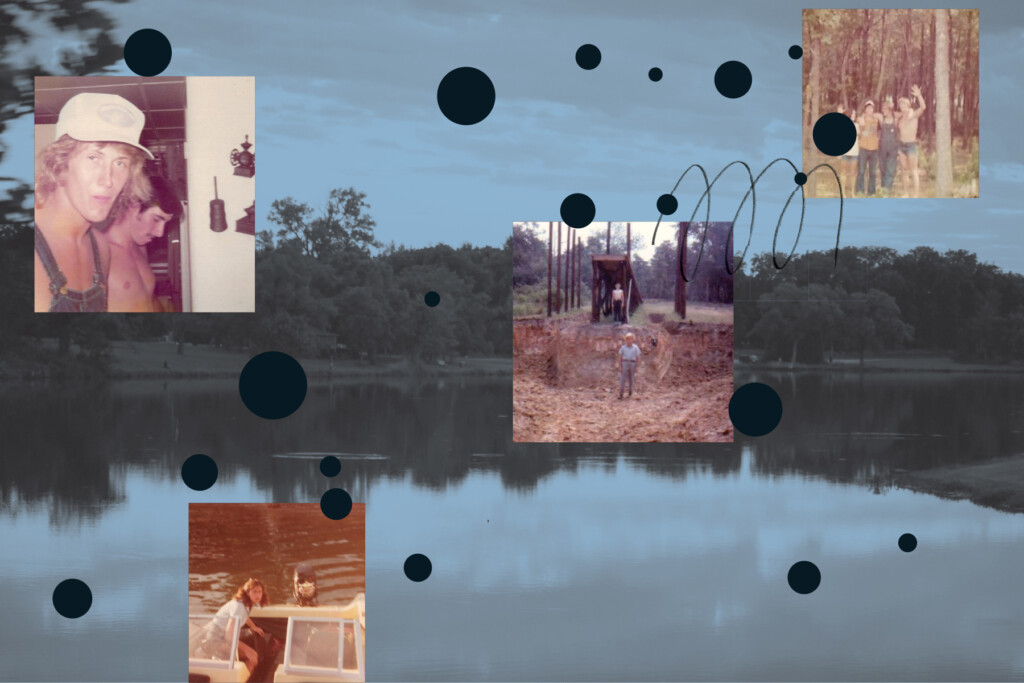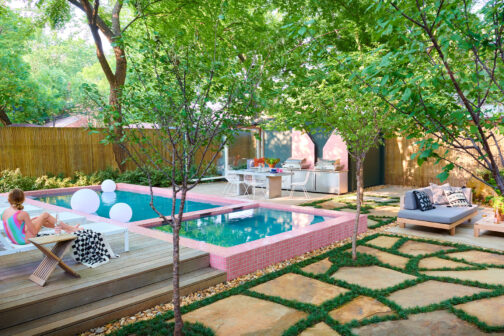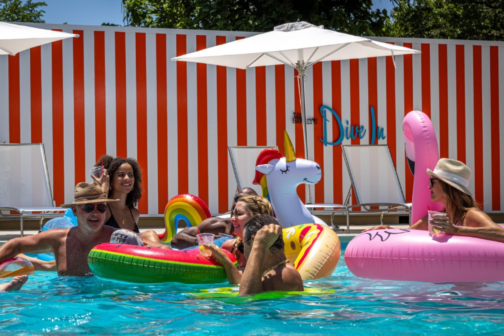What my dad said made no sense. Then again, I was only 9.
“That’s where the lake is going to be.”
I looked around. Our family of four had driven about an hour east from our home in Dallas, past fields of cotton, herds of livestock, and a couple of small towns, and finally turned down a narrow gravel road, stopping in the middle of what appeared to be as dense a jungle as I had imagined from reading Kipling’s Jungle Book.
My mind was still trying to process what Dad had said when he repeated, “This is where the lake is going to be.”
I knew what a lake looked like. My grandparents had a cabin on Lake Lavon, just north of their home in Mesquite. I had climbed into the cab of Grandaddy’s ’49 Studebaker pickup many a Saturday morning for the half-hour drive, marveling that I could see the pavement through the holes in the rusted-out floorboard as we traveled Highway 67 toward Rockwall. Dandy, Grandaddy’s fox terrier, sat between us on the worn bench seat, sometimes standing with his paws on the dash, peering out the windshield.
After launching Grandaddy’s 16-foot Lone Star boat at Little Ridge Park and a couple of yanks on the rope, his 10-horsepower Evinrude would sputter to life. An orange life jacket pulled snugly around my neck; I loved sitting on the narrow bench at the bow, holding tightly to a rope tied to the cleat as the tiny boat bounced over the whitecaps, making it a thrilling ride for a 6-year-old.
Grandaddy taught me how to bait the hook and then patiently watch the red-and-white plastic bobber at the end of my line. It was important that, when the bobber dipped underwater, you waited until the crappie had the hook firmly in his mouth. If you jerked too quickly, you’d just lose your bait. Grandaddy also taught me at an early age that you were no kind of fisherman until you had learned to stick your fingers down the mouth of a fish you had caught, pull out the hook, and then drop him in the metal fish basket hanging over the side of the boat.
Dad’s prophecy came true, of course. At 12, I stood on the same narrow gravel road, but now, peering through the dense foliage, I could see—barely—water. Lots of water. We climbed back into the car and drove to the end of the road, and I could see a huge concrete dam in the distance.
“It’s called Cedar Creek,” Dad said, “and someday we’re going to build a house and boat dock on that lot.”
Like so many middle-class, suburban families in the ’60s, we had joined the wave that was taking advantage of the newfound prosperity and opportunities provided after World War II. Reservoirs like the one at Cedar Creek were being built all over Texas to provide water for growing cities, and for a while the land around the lakes was relatively cheap. The lakefront lot my parents bought on Cedar Creek Lake only cost $1,200 (about $12,000 in today’s dollars, accounting for inflation). We were among the pioneers in this movement.
Arrowwood Shores, where our lot was located, had strict restrictions for the properties. We couldn’t camp or stay overnight until the house was built, which was OK with me. I was entrenched in Little League and swim team, and was about to enter junior high. Besides, I had grown out of those fishing trips with Grandaddy.
And then, one Friday evening, Dad pulled into the driveway and surprised us all, even Mom, who stared in disbelief. Behind his truck was a boat. Unlike Grandaddy’s tiny aluminum boat, this was yellow fiberglass, long and low, with an open bow and black seats that matched the tall Mercury outboard on the back. For me, it was love at first sight.
The following weekend, we began what would become a 30-year adventure at Cedar Creek Lake, joining three other families we knew at Cherokee Landing, a campground they had been frequenting every weekend for a couple of years. At the far eastern edge of the lake, the new campground had a beach with a swimming area, boat storage and a launching ramp, a store, and rental spots for RVs, campers, and tents. Each of the other families had campers and a boat similar to ours. We set up camp in a circle, with lawn chairs, picnic tables, and Coleman stoves in the middle. Ice chests filled with beer marked the perimeter. The moms cooked, and we ate all the meals together. At night, the kids—eight of us ranging in age from 9 to 12, with me being the eldest—played card games and listened to Top 40 radio from KLIF in Dallas.
My love affair with the lake began the first time Dad fired up that big Merc and we headed across the water.
But my love affair with the lake began the first time Dad fired up that big Merc and we headed across the water. Somehow he had managed to buy an outboard motor with 40 more horsepower than his friends’ boats. It was 1967, and with a top speed of 50 mph, it was one of the fastest boats on Cedar Creek Lake. A pair of water skis came with our new boat, and by noon that first Saturday, my sister, Loraine and I were slicing back and forth across the wakes with a tiny neoprene belt around our waists. The next day I learned to slalom, and it wasn’t long before I was loading up our boat with kids and pulling them on skis. Loraine, only 9, drove when I skied; no parents needed.
When we stopped to change skiers, you could look in every direction and see a few scattered lake houses on the shore, a couple of fishermen slowly trolling near the bank, and occasionally another ski boat. Dad wasn’t worried. He had schooled me in boating safety and trusted me. The reality was, of course, on this brand-new, undeveloped lake, there really wasn’t anything to run into.
We spent every weekend for two wonderful summers at Cherokee Landing, but it was over an hour’s drive from our home. Looking for something closer, Dad and his friends found a new campground only 45 minutes away, in Tool City, on the west side of the lake. By now, we had upgraded to RVs that were left at the campsite year-round, and we kept our boat and equipment in storage there, as well.
This new campground, between Paradise Bay and Don’s Port Marina, was in an area where lakefront houses had popped up all along the shore. There were more boats on the water, but most were fishermen. The only problem was that the fishermen always seemed to be fishing in the exact spot we wanted to ski. Always looking for the calmest, smoothest water, usually in a cove near the shore, we would find a fishing boat sitting right in our path.
“Why can’t they just fish out in the middle of the lake?” we wondered.
I’m pretty sure the fishermen were asking the same thing about us. Hoping to run them off, we would ski within 25 feet of them, our wake rocking their boats, often prompting a clenched fist shaken at us and occasionally a lure cast in our direction. We weren’t worried. They couldn’t catch us. That all changed when fishing boats added 200-horsepower engines that could run 60 mph.
Getting my driver’s license at 16 was a game-changer. I already knew every square inch of the lake, and our yellow ski boat could be seen every weekend, racing from one end to the other. But now I could explore the nearby towns such as Seven Points and Gun Barrel City, both of which sat right on the shore. Halfway between Don’s Port Marina and Seven Points, on Highway 274, was the Tool City Hall, headquarters for the Tool City Police Department. Their one patrol car was a Dodge Dart sedan with a single light on top. Knowing that cruiser couldn’t catch us in my dad’s Buick with the 455 V-8, I would speed by at night with a carload of kids, honking, hoping he might come after us. A few times, he did, but once his red light faded in the distance, we would turn onto one of the blacktop roads and disappear into the night.
When I reached high school, I met several new friends who had weekend homes on the lake. Some were familiar with the yellow boat pulling skiers past their boat docks, especially since I was among the few that could barefoot ski, a rare phenomenon back then. My new friends and I became adept at spotting sunbathers on their boat docks and found that the best way to meet girls was to ski past as close as possible, cut, and spray water on them. Irritated at first, most had a change of heart when we pulled up to their dock and offered to take them skiing.
The best way to meet girls was to ski past as close as possible, cut, and spray water on them.
By the time I reached my senior year of high school, the once-barren shoreline of Cedar Creek was covered with homes and boat docks. Gun Barrel City was still little more than a few convenience stores and small businesses, but Seven Points had several gas stations, restaurants, and bars, including a large dance hall called the Western Club. Even before the Urban Cowboy craze, the parking lot of the Western Club was packed with hundreds of cars every weekend, and artists such as Johnny Bush played regularly. With the drinking age at 18, we spent most Saturday nights two-stepping with the local girls from nearby Kemp, Trinidad, and Mabank.
My sister became very involved in church and high school activities, so my parents weren’t going to the lake as often. But that didn’t stop me. I was still heading to the lake every weekend, and, on occasion, a group of us would skip school on a Friday and head down to ski all day. If I didn’t stay overnight at a friend’s lake house, I would just anchor in the middle of the lake, lay down the seats, and sleep to the gentle rocking of the boat.
The college I attended was only a few miles from Lake Texoma, and it even had a lake campus we often visited. A friend and I began skiing competitively, and we skied on bayous in Louisiana, channels near Houston, and lakes all over Texas. But none compared to Cedar Creek, and every chance I got, I headed back to East Texas and hopped in that yellow boat.
My sister graduated from high school in 1977, and it finally happened: my parents built their dream home on the lot they had bought 10 years previous. By then, much of the subdivision had filled, with lakefront houses everywhere. To build their home, my folks had to remove 20 trees, but there were still close to 50 left. They built a three-bedroom, two-bath brick home and later added a boathouse with a pier and deck on the 75 feet of shoreline they owned. Dad planted lush St. Augustine grass. When the place was finished, they moved from Dallas and made their home on the lake a full-time reality.
Shortly after my folks moved to Cedar Creek, I finished college, moved to Dallas, and trips to the lake became less frequent. When I did visit, the change was noticeable. Towns such as Mabank and Kemp began to grow. Gun Barrel City became a major hub, adding grocery stores and businesses. But the most radical change was taking place in my parents’ subdivision. Huge two-story houses with elaborate boathouses were being built. One home had white sand trucked in from Florida for its beach. And unlike the permanent residents already living there, these were weekend homes.
During the ’80s, my sister and I both married and began raising families. Trips to the lake usually revolved around holidays. With small children, we weren’t on the water much, and Dad even sold the yellow ski boat and bought a bass boat. His job required a lot of travel, and without us around to help, it became difficult for him to keep up the house and yard.
In only 25 years, Cedar Creek Lake had seen so much change. My folks took advantage of the increased value of their property and sold the lake house for five times what they had put into it, enough to pay cash for and remodel a home in Mineola, near my sister. For me, with a growing family, job, and plenty of other activities, Cedar Creek Lake became a distant memory.
Even before the Urban Cowboy craze, the parking lot of the Western Club was packed with hundreds of cars.
About 10 years ago, though, a friend from high school, who had often gone to the lake with me, called to tell me he had bought a lake house on Cedar Creek. He was hoping our family could spend a weekend with them.
I loaded up the family and headed east, marveling at how much things had changed. I remembered State Highway 175 as a two-lane blacktop. Now it was a four-lane expressway. Tiny gas stations where we once bought a gallon of gas for a quarter were replaced with large convenience stores with fast-food restaurants inside. Seven Points looked much different, now somewhat rundown, with a slew of empty buildings. Crossing the lake and pulling into Gun Barrel City, I could see why. The tiny burg that had once been the site of a few bait shops and a tire store, now had a Super Walmart, Chili’s, and Starbucks, among dozens of other businesses.
My friend’s home in Enchanted Oaks was an older cabin built shortly after the dam had been completed. Even so, it had been remodeled and was very nice. But all around his place stood huge, new homes. The home next door even had a tennis court looking out over the water.
We loaded our families into his boat, and I remembered our yellow ski boat and all the fun times I had had in it. His boat was longer, nicer, and much faster, and in a matter of minutes, we had crossed the lake. We pulled into the marina at Don’s Port and fueled up, just as we had many years before. We drove through the coves where we once skied. Buoys limiting speed to 5 mph were everywhere, making it illegal to ski where we’d once tormented fishermen. Back out on the main water, I was amazed at the number of boats and personal watercraft. Though no wind was blowing, the lake was as choppy as if a storm was rising, all from boat wakes. I couldn’t see how anyone could have fun skiing on this mess.
We finally reached our destination, the cove where we had once lived, in the Arrowwood subdivision. The shoreline was packed with gigantic homes, white beaches, and boathouses with not just one boat but several. As we slowly navigated the cove, I strained to remember where our house had been. My friend pointed and said, “That’s where it was.”
The new owners had razed it and built a three-story mansion and a boathouse with a deck on top that held a Ski Nautique, a deck boat, and four Sea-Doos. The boathouse alone was bigger than my parents’ home had been.
It was at that moment, I remembered my dad’s words: “That’s where the lake is going to be.”
He was right about the lake. But he could never have foreseen what else was to come.
This story originally appeared in the July issue of D Magazine with the headline, “Life Aquatic.” Write to [email protected].
Author







